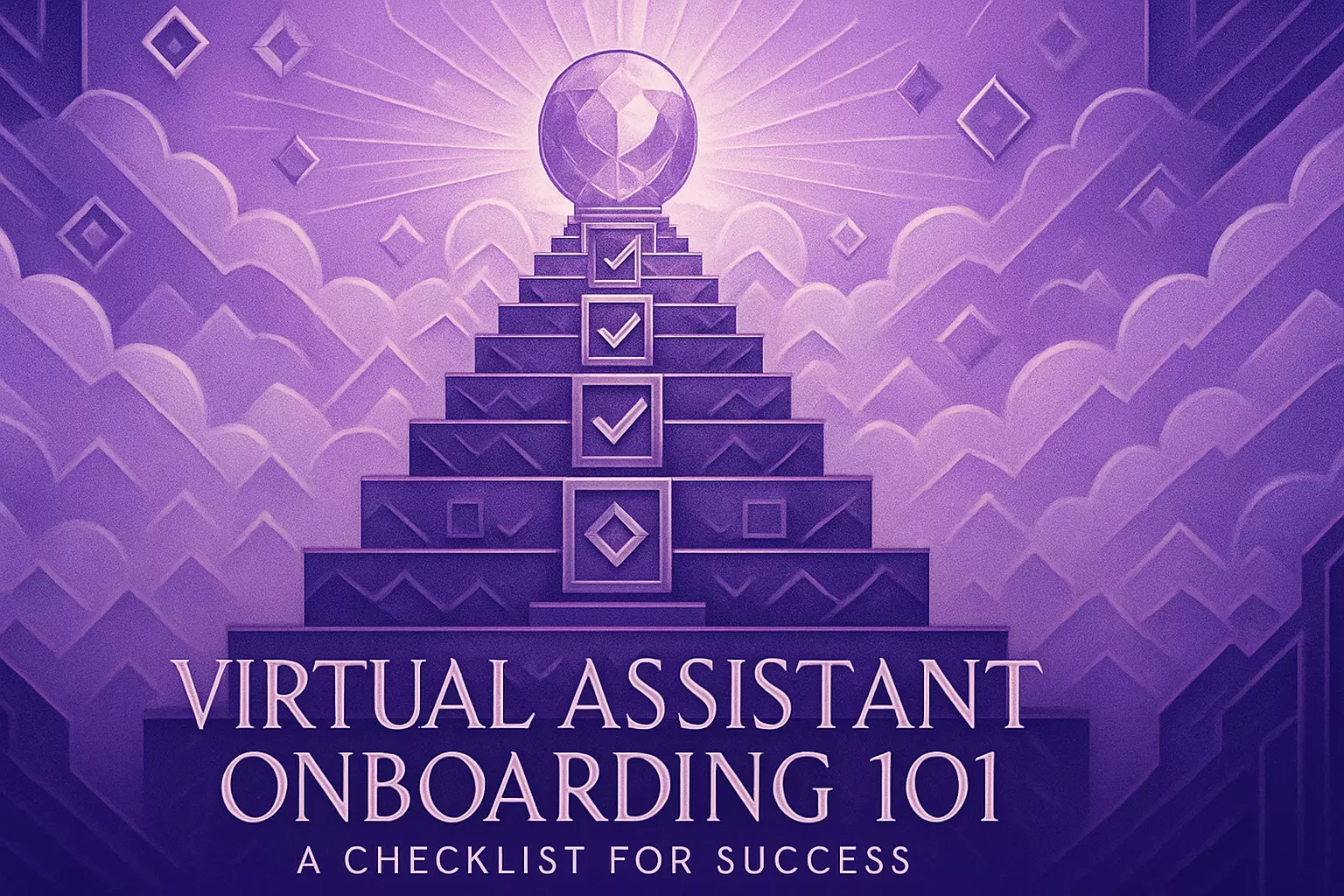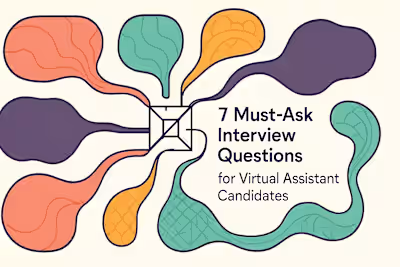Virtual Assistant Onboarding 101: A Checklist for Success

Virtual Assistant Onboarding 101: A Checklist for Success
Phase 1: Pre-Onboarding Preparation
Define Roles, Responsibilities, and Expectations
Set Up Essential Tools and Access
Prepare Key Documentation
Phase 2: The First Week - Integration and Training
Schedule a Welcome and Orientation Meeting
Provide Structured Training
Establish Communication Protocols
Phase 3: The First 30-90 Days - Ramping Up and Building Trust
Set Clear Goals and KPIs
Implement a Feedback Loop
Gradually Increase Responsibility
Building Long-Term Success
References
Virtual Assistant Onboarding 101: A Checklist for Success
Hiring a virtual assistant (VA) can transform your business, but a successful partnership starts with a structured onboarding process. A great hire is only as effective as their integration into your team. This guide provides a comprehensive checklist to ensure your new VA is set up for success from day one, fostering a productive and long-lasting relationship.
A smooth onboarding process involves more than just a welcome email; it requires thoughtful preparation, clear communication, and the right resources, including having the best tools for collaboration. To find the right independent professional for your needs, you can easily hire a virtual assistant on Contra.
Think of onboarding like welcoming a new neighbor. You wouldn't just hand them the keys and disappear. You'd show them around, introduce them to the community, and make sure they have everything they need to feel at home. The same principle applies to your new VA.
Phase 1: Pre-Onboarding Preparation
Before your VA's first day, lay the groundwork for a smooth start. This phase is about preparing all the necessary access, documentation, and tools they'll need to hit the ground running. Proper preparation prevents first-day delays and shows your new VA that you're organized and ready for them.
I've seen too many businesses rush this phase. They hire someone great, then scramble to figure out what the VA should actually do. That's like inviting someone to dinner without planning the menu. Let's avoid that chaos.
Define Roles, Responsibilities, and Expectations
Start by getting crystal clear on what you need. Write down every task you want your VA to handle. Be specific. Instead of "manage social media," write "post three times weekly on Instagram, respond to comments within 24 hours, and create a monthly content calendar."
Create a detailed job description that covers daily, weekly, and monthly tasks. Include performance expectations, deadlines, and quality standards. If you expect emails answered within four hours, say so. If reports need specific formatting, provide examples.
Share this document with your VA before they start. It sets clear expectations and prevents the dreaded "I didn't know I was supposed to do that" conversation later. Think of it as your working agreement – a roadmap both of you can reference.
Don't forget to include growth opportunities. VAs appreciate knowing there's room to expand their role. Maybe they start with email management but could eventually handle client communications. Paint that picture.
Set Up Essential Tools and Access
Nothing kills momentum like a VA waiting three days for login credentials. Before their start date, create accounts for every platform they'll need. This includes your communication tools, project management systems, file-sharing drives, and any specialized software.
Use a secure password manager to share credentials safely. Tools like LastPass or 1Password let you grant access without revealing actual passwords. Create a dedicated vault or folder just for your VA's credentials.
Test everything beforehand. Log in with their credentials to ensure access works properly. Check permission levels too. Your VA needs enough access to do their job but shouldn't see sensitive financial data unless necessary.
Create a master list of all tools with brief descriptions of what each one does. Include links to tutorials or help documentation. Remember, what seems obvious to you might be new to them.
Prepare Key Documentation
Your welcome packet is like a survival guide for your business. Start with a company overview that explains your mission, values, and goals. Help your VA understand not just what you do, but why you do it.
Include team member introductions with photos, roles, and fun facts. Remote work can feel isolating, so humanize your team. Maybe Sarah in accounting loves hiking, or Tom in sales has three cats. These details matter.
Document your standard operating procedures (SOPs) for common tasks. Use screenshots, videos, or step-by-step guides. The more detailed your SOPs, the less hand-holding you'll need to do later.
Add practical information like time zones, holiday schedules, and communication preferences. If you're unavailable on Fridays or prefer texts for urgent matters, document it. Create a FAQ section addressing common questions new team members typically ask.
Phase 2: The First Week - Integration and Training
The first week is critical for integrating your VA into the team and your workflows. Focus on structured training, establishing communication rhythms, and assigning initial tasks to build their confidence.
This week sets the tone for your entire working relationship. Too much information overwhelms them. Too little leaves them confused. Strike the right balance by focusing on immediate needs while gradually introducing broader concepts.
Schedule a Welcome and Orientation Meeting
Your first meeting should feel like a warm welcome, not a job interview. Use video to create a personal connection. Seeing faces builds trust faster than endless emails.
Start with introductions. Share a bit about yourself beyond work. Maybe you're learning guitar or training for a marathon. Encourage your VA to share too. These personal connections matter in remote relationships.
Walk through the onboarding plan together. Show them what to expect in the coming days and weeks. This reduces anxiety and helps them mentally prepare. Review your communication style and preferences. Are you a morning person? Do you prefer detailed updates or quick summaries?
End the meeting by assigning their first task and scheduling the next check-in. They should leave feeling excited and clear about next steps, not overwhelmed or confused.
Provide Structured Training
Avoid the information fire hose. Break training into digestible chunks spread across several days. Day one might cover communication tools. Day two tackles project management. Day three focuses on specific job tasks.
For each tool or process, follow the "show, do, review" method. First, demonstrate the task while explaining your thought process. Then, have them complete it while you observe. Finally, review their work together and address questions.
Assign a small, manageable first task that guarantees success. Maybe it's organizing a shared folder or scheduling a week of social media posts. This early win builds confidence and momentum.
Record training sessions when possible. Your VA can revisit these videos later without feeling embarrassed about asking again. Plus, you'll build a training library for future hires.
Establish Communication Protocols
Clear communication prevents 90% of remote work problems. Define your channels early. Email for non-urgent matters. Slack for quick questions. Phone calls for emergencies. Whatever you choose, be consistent.
Set response time expectations for both sides. If you need answers within two hours, say so. But also commit to responding to their questions promptly. Respect goes both ways.
Schedule regular check-ins beyond the first week. Daily 15-minute calls work well initially, then taper to weekly as they gain confidence. These aren't micromanagement sessions – they're support opportunities.
Create a shared document for ongoing questions. Your VA can add queries throughout the day, and you can address them during check-ins. This prevents constant interruptions while ensuring nothing falls through cracks.
Phase 3: The First 30-90 Days - Ramping Up and Building Trust
Beyond the first week, the focus shifts to performance, feedback, and building a strong working relationship. This period is about gradually increasing responsibility and fostering long-term success.
Think of this phase as moving from training wheels to independent riding. Your VA knows the basics. Now they need practice, feedback, and gradually expanding challenges to reach their full potential.
Set Clear Goals and KPIs
Vague expectations lead to disappointment. Define specific, measurable goals for your VA's role. Instead of "improve customer service," set targets like "respond to all customer emails within 24 hours with 95% satisfaction rating."
Work with your VA to establish these KPIs. They might have insights about what's realistic or suggest additional metrics. This collaboration creates buy-in and ensures goals feel achievable, not imposed.
Create a simple tracking system. A shared spreadsheet works fine. Track metrics weekly at first, then monthly as patterns emerge. Focus on trends, not daily fluctuations.
Remember that KPIs should evolve. What matters in month one might change by month three. Regular reviews keep goals relevant and challenging without being overwhelming.
Implement a Feedback Loop
Feedback is the breakfast of champions, but many people serve it wrong. Create a structured approach that balances recognition with growth opportunities.
Schedule formal feedback sessions monthly. These aren't performance reviews – they're growth conversations. Start with what's working well. Be specific. "Your email responses are thorough and professional" beats "good job."
Address challenges constructively. Focus on behaviors, not personality. "The report was submitted two days late" is actionable. "You're disorganized" is just hurtful. Always couple criticism with support or resources.
Encourage your VA to share feedback too. What would make their job easier? What processes seem inefficient? Their fresh perspective might reveal improvement opportunities you've overlooked.
Document feedback conversations. A simple shared document tracking discussions, commitments, and progress helps both parties stay accountable and see growth over time.
Gradually Increase Responsibility
Trust builds through consistent small steps, not giant leaps. Start by delegating tasks with clear parameters. As your VA succeeds, expand their autonomy.
Maybe they begin by following your social media calendar exactly. After a month of consistent execution, let them suggest post ideas. By month three, they might own the entire calendar creation process.
Look for signs they're ready for more. Are they completing tasks faster? Asking strategic questions? Suggesting improvements? These indicate capacity for greater responsibility.
Be transparent about growth opportunities. Share your vision for their expanding role. This motivates high performers and helps them see a future with your company.
Remember that increased responsibility should come with increased recognition. This might mean a title change, pay increase, or simply public acknowledgment of their expanding contributions.
Building Long-Term Success
A successful VA relationship doesn't happen by accident. It requires intentional effort, clear communication, and mutual respect. The time you invest in proper onboarding pays dividends through increased productivity, reduced turnover, and a stronger business.
Your VA isn't just a task-doer. They're a strategic partner who can transform how you operate. Treat them as such from day one. Share your vision. Involve them in decisions. Celebrate their wins.
Remember that onboarding isn't a one-time event. It's an ongoing process of growth, adjustment, and relationship building. Stay flexible. What works for one VA might need tweaking for another.
The checklist in this guide provides structure, but don't let it replace human connection. Behind every VA is a person with goals, challenges, and unique talents. The more you recognize and nurture their humanity, the stronger your partnership becomes.
Start implementing these strategies with your next VA hire. You'll be amazed at how proper onboarding transforms a good hire into an exceptional team member. Your future self will thank you for the investment.
References
Like this project
Posted Jun 30, 2025
Set your new virtual assistant—and your business—up for success. Our essential onboarding checklist covers everything from pre-start prep to long-term growth.










